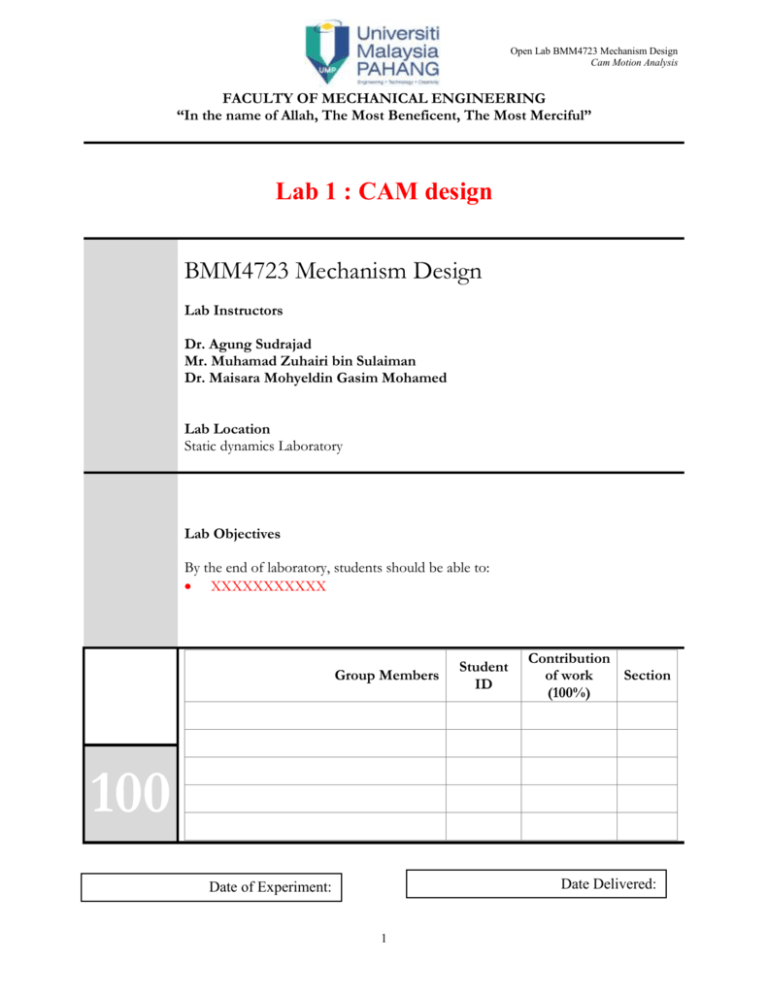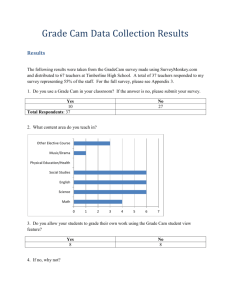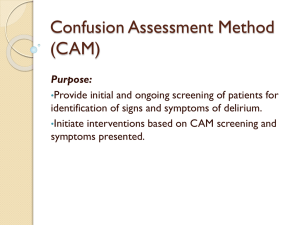
Open Lab BMM4723 Mechanism Design
Cam Motion Analysis
FACULTY OF MECHANICAL ENGINEERING
“In the name of Allah, The Most Beneficent, The Most Merciful”
Lab 1 : CAM design
BMM4723 Mechanism Design
Lab Instructors
Dr. Agung Sudrajad
Mr. Muhamad Zuhairi bin Sulaiman
Dr. Maisara Mohyeldin Gasim Mohamed
Lab Location
Static dynamics Laboratory
Lab Objectives
By the end of laboratory, students should be able to:
XXXXXXXXXXX
Group Members
20
Student
ID
Contribution
of work
Section
(100%)
100
Date Delivered:
Date of Experiment:
1
Open Lab BMM4723 Mechanism Design
Cam Motion Analysis
An Evaluation of Profiles for Disk Cams with In-line Roller Followers in
Horizontal Position
Name1, Name2, ……., Name15
Faculty of Mechanical Engineering, Universiti Malaysia Pahang, Pekan, 26600 Gambang,
Kuantan, Pahang, Malaysia.
Abstract: ……………………….
Keywords: …………………………….
INTRODUCTION
………………………………
EXPERIMENTS
……………………………..
Cam Mechanism Analysis System
In analyzing cam motion mechanism, the machine that had been used is cam mechanism analysis
system, as shown in Fig. x. This system is used Dewesoft software to run and gathering the
experimental data.
LVDT
Follower
Cam
Figure x. Cam mechanism analysis system
From this experiment, the parameters that gathered were displacement (s), velocity (v) and
acceleration (a) of the follower. From this data, the performance of the cam and follower system
can be analyzed and had been compared with the theoretical analysis.
Data collection method
From the …….. shape of cam that had be used, the performance of this type of the cam using
kinematics parameter can be differentiate from the experiment in the cam mechanism analysis
system using different speed of cam. In this experiment, the speeds of cam that used were 100
rpm, 200 rpm, 300 rpm, 400 rpm, 500 rpm and 600 rpm.
2
Open Lab BMM4723 Mechanism Design
Cam Motion Analysis
RESULTS & DISCUSSION
From the experiment, the output is in form of graphs (displacement, torque, force, vibration and
speed) versus time (Fig. xx), and the raw data is about the 60000 data for every single
experiment. Figure below show mode output data while doing experiment with input 100 rpm.
Figure xx. Graphs of output data of 100 rpm for one complete cycle
The data gathered can be interpreted due to kinematics analysis, which meaning that, the data
can be reconstructed in form of displacement, velocity and acceleration analysis. For that, the
data for one cycle of cam rotation (β =360o) was determined.
Fig. xxx shows the displacement diagram, velocity diagram, and acceleration diagram, after
reconstructed of the output data for one complete cycle of the experiment using speed of 100
rpm.
FIGURE
Figure xxx. Follower displacement diagram (a), velocity diagram (b) and acceleration diagram
(c) versus cam angle at 100 rpm
For other input value (200 rpm, 300 rpm, 400 rpm, 500 rpm, 600 rpm), its show same pattern
of graph. In the follower displacement graphs, they have same value and same pattern graph of
the diagram. The differences among the input value are the maximum value of velocity and
acceleration that has change constantly with the change of speed of the cam (see Fig. xxxx and
Fig. xxxxx). For this shape of cam, the maximum value of displacement, velocity and
acceleration are summarized in the Table 1 according to the input value.
FIGURE
Figure xxxx. Follower velocity diagram in 6 different speeds
FIGURE
Figure xxxxx. Follower acceleration diagram in 6 different speeds.
3
Open Lab BMM4723 Mechanism Design
Cam Motion Analysis
Fig. xxxx shows …… discussion
In contrast with the follower acceleration diagram (Fig. xxxxx), ………discussion
Table 1. Maximum values for experimental method
Speed
(rpm)
100
200
300
400
500
600
Displacement
(mm)
Velocity
(mm/s)
Acceleration
(mm/s2)
Cam profile analysis
From Fig. xxxxxx, it shows a little difference between graphical method and experimental
method. It may occur when reconstruction of cam profile between actual cam compare to
experimental data. But from analysis, it shows the small different between actual cam and
experimental data of construction cam.
60
graphical
experimental
50
40
Coordinate Ry (mm)
30
20
10
0
-40
-30
-20
-10
0
10
20
30
40
-10
-20
-30
-40
Coordinate Rx (mm)
Figure xxxxxx. Comparison of cam profile between graphical and experimental methods
From comparison between graphical and experimental methods, …………. discussion
Table 2. Error occur during the experiment compare to graphical methods
Speed
(rpm)
100
200
Displacement
(%)
Velocity
(%)
4
Acceleration
(%)
Open Lab BMM4723 Mechanism Design
Cam Motion Analysis
300
400
500
600
The detail of the percentage errors between graphical and experimental methods had been
summarized………….. discussion
CONCLUSION
……………………………….
ACKNOWLEDGMENT
The authors would like to express their thanks to……………
REFERENCES
1. Zhang Y., Finger S. and Behrens S., (2006), Rapid Design through Virtual and Physical
Prototyping, Carnegie Mellon University.
2. Erdman A.G. and Sandor G.N., (1964), Mechanism Design: Analysis and Synthesis Vol. 1,
3.
4.
5.
6.
7.
8.
9.
10.
Prentice Hall, New Jersey.
Chen F. Y., (1982), Mechanics and Design of Cam Mechanisms, Pergamon Press, New York.
Myszka D.H., (2005), Machines & Mechanisms, Pearson Prentice Hall, Third Edition, New
Jersey.
Jensen P. W., (1987), Cam Design and Manufacture 2nd ed, Marcel Dekker Inc.
Lee R. S. and She C. H., (1998). Tool path Generation and Error Control Method for Multi
Axis NC machining of Spatial Cam. International Journal Machine Tools Manufacturing. 38
(4) 277-290.
Rothbart, H.A., (2005), Cam Design Handbook. McGraw-Hill Handbooks, New York.
xxxx
xxxx
xxxx
5










